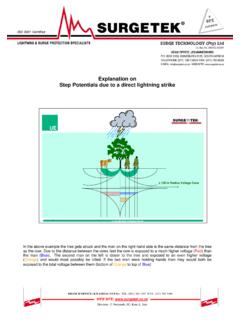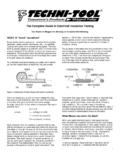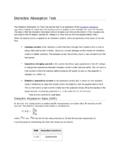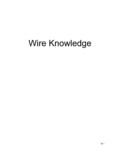Transcription of Above 1 kV Insulation Testing A Guide To Diagnostic
1 UNITED STATES4271 Bronze WayDallas, TX 75237-1017T (800) 723 2861F (214) 333 3533PO Box 9007 Valley Forge, PA 19485-1007T (610) 676 8500F (610) 676 8610 UKArchcliffe Road, DoverKent CT17 9EN England T (0) 1 304 502101 F (0) 1 304 207342 CANADA110 Milner Avenue, Unit 1 Scarborough, Ontario M1S 3R2 CanadaT 1 800 567 0286T 450 659 4500 In QuebecF 1 416 298 0848 FRANCE29, All e de Villemomble93340 Le RaincyFranceT Guide To DiagnosticInsulation Testing Above 1 kVMEGGER Insulation Testers1 NOTEST able of 2 WHAT IS Insulation ? .. 3 What Causes Insulation to Degrade? .. 3 electrical Stress ..3 Mechanical Stress .. 3 Chemical Attack .. 3 Thermal Stress .. 4 Environmental Contamination .. 4 How Can Predictive Maintenance Help Me? .. 4 The Benefit of New Technology .. 5 HOW Insulation RESISTANCE IS 6 How an Insulation Resistance Tester Operates.
2 6 Components of Test Current .. 6 Capacitive Charging Current .. 6 Absorption or Polarization Current .. 6 Surface Leakage Current .. 7 Conduction Current .. 7 Connecting your Insulation Tester .. 8 Selected Typical Connections .. 9 Shielded Power Cable .. 9 Circuit Breaker/Bushings .. 9 Power Transformer .. 10AC Generator .. 10 Insulation Resistance Tester Scale .. 11 Voltage Characteristics .. 12 EVALUATION AND INTERPRETATION OF 13 Interpretation of the Infinity ( ) Reading .. 13 Diagnostic HIGH VOLTAGE Insulation 15 Spot Reading Test .. 15 Time vs. Resistance Test .. 17 Polarization Index Test .. 18 Step Voltage Test .. 20 Dielectric Discharge Test .. 21 Different Problems/Different Tests .. 24 Potential Sources of Error/Ensuring Quality Test Results .. 24 Test Leads .. 24 Making Measurements Above 100 G ..24 Accuracy Statements.
3 24 Delivery of Stated Voltage .. 24 Interference Rejection .. 25 Rules on Testing and Comparing .. 25 Testing Insulation Resistance on Rotating Machinery .. 26 The Guard Terminal .. 29 Effects of Temperature .. 31 Effects of Humidity .. 33 Ingress Protection .. 33 High Potential Testing .. 35 Current (nA) Readings vs. Resistance (M ) Readings .. 35 Burn Capability .. 36 Drying out electrical Equipment .. 36 Test Item Discharge .. 38 Charging Time for Large Equipment .. 39 Motor Driven Insulation Testers .. 39 Insulation TESTERS AVAILABLE FROM 40 Second Edition: 2002 2002 MeggerMegger is a world leadingmanufacturer and supplier oftest and measurementinstruments used within theelectric power, building wiringand research, engineering andmanufacturing facilities in theUSA and UK, combined withsales and technical support inmost countries, Megger isuniquely placed to meet theneeds of its more information aboutMegger and its diversified lineof test and measurementinstruments look us up on theweb at Guide to Diagnostic Insulation Testing Above 1 kVNOTESINTRODUCTIONE lectrical Insulation degrades over a period of time because of various stresses,which are imposed upon it during its normal working life.
4 The Insulation hasbeen designed to withstand these stresses for a period of years, which would beregarded as the working life of that Insulation . This often runs into stresses can bring about an increase in this natural aging process thatcan severely shorten the working life of the Insulation . For this reason it is goodpractice to perform regular Testing to identify whether increased aging is takingplace and, if possible, to identify whether the effects may be reversible or purpose of Diagnostic Insulation Testing is: To identify increased aging. To identify the cause of this aging. To identify, if possible, the most appropriate actions to correct the its simplest form Diagnostic Testing takes the form of a Spot Test. Mostelectrical maintenance professionals have made spot tests where a voltage isapplied to the Insulation and a resistance is measured.
5 The diagnosis in this caseis limited to the Insulation is good or the Insulation is bad. But having madethis diagnosis what do we do about it? It s a bit like going to the doctor with abad cough and the doctor simply telling you, You ve got a bad cough. Youwouldn t be happy to come away with only that information. You expect thedoctor to examine you, carry out a few tests, and tell you why you have a badcough and what to do about it to cure the Insulation Testing , a spot test on its own is the equivalent of the doctor tellingyou that you are well or you are sick. It s minimal information. This is the sort oftest that is typically applied to low-voltage circuits where the cost of a failure islow and equipment can be replaced easily and inexpensively. Since the equip-ment being tested is low voltage equipment, these tests are typically performedusing a 500 or 1000 V test voltage and will be familiar to all electrical mainte-nance , if the doctor records the results of his examination and compares themwith those from previous visits, then a trend might be apparent which couldlead to medication being prescribed.
6 Similarly, if Insulation resistance readingsare recorded and compared with previously obtained readings, it may be pos-sible to see a trend and to prescribe remedial actions if such are called Insulation Testing at voltages Above 1 kV is an area that is less famil-iar to many electrical maintenance personnel. The purpose of this booklet, there-fore, is to: Acquaint the reader with making Diagnostic Insulation resistance tests. Provide guidelines for evaluating the results of these Diagnostic insulationresistance tests. Introduce the benefits of multi-voltage Testing at higher series of appendices are included at the end of the booklet to provide thereader with additional information related to Diagnostic Insulation Insulation Testers3 NOTESThis booklet is based on the principles established in the booklet A Stitch The complete Guide to electrical Insulation Testing first published in1966 by the James G.
7 Biddle IS Insulation ?Every electric wire in a facility, whether it s in a motor, generator, cable, switch,transformer, or whatever is covered with some form of electrical the wire itself is a good conductor (usually made of copper or aluminum)of the electric current that powers electrical equipment, the Insulation mustresist current and keep the current in its path along the conductor. Understand-ing Ohm s Law, which is expressed in the following equation, is the key to un-derstanding Insulation Testing :E = I x Rwhere,E = voltage in voltsI = current in amperesR = resistance in ohmsFor a given resistance, the higher the voltage, the greater the current. Alterna-tively, the lower the resistance of the wire, the more current that flows for thesame Insulation is perfect (has infinite resistance), so some current does flow alongthe Insulation or through it to ground.
8 Such a current may be insignificantlysmall for most practical purposes but it is the basis of Insulation Testing what is good Insulation ? Good means a relatively high resistance tocurrent flow. When used to describe an Insulation material, good also means the ability to maintain a high resistance. Measuring resistance can tell youhow good the Insulation Causes Insulation to Degrade?There are five basic causes for Insulation degradation. They interact with eachother and cause a gradual spiral of decline in Insulation StressInsulation is designed for a particular application. Overvoltages andundervoltages cause abnormal stresses within the Insulation , which can lead tocracking or delamination of the StressMechanical damage such as hitting a cable while digging a trench is fairly obvi-ous but mechanical stresses also may occur from running a machine out of bal-ance or frequent stops and starts.
9 The resulting vibration from machine opera-tion may cause defects within the AttackWhile you would expect Insulation to be affected by corrosive vapors, dirt andoil can also operate to reduce the effectiveness of Guide to Diagnostic Insulation Testing Above 1 kVNOTEST hermal StressRunning a piece of machinery in excessively hot or cold conditions will causeover expansion or contraction of the Insulation which might result in cracks andfailures. However, thermal stresses are also incurred every time a machine isstarted or stopped. Unless the machinery is designed for intermittent use, everystop and start will adversely affect the aging process of the ContaminationEnvironmental contamination covers a multitude of agents ranging from mois-ture from processes, to humidity on a muggy day, and even to attack by rodentsthat gnaw their way into the begins to degrade as soon as it is put in service.
10 The Insulation in anygiven application will have been designed to provide good service over manyyears under normal operating conditions. However, abnormal conditions mayhave a damaging effect which, if left unchecked, will speed up the rate of deg-radation and will ultimately cause a failure in the Insulation . Insulation is deemedto have failed if it fails to adequately prevent electrical current from flowing inundesirable paths. This includes current flow across the outer or inner surfacesof the Insulation (surface leakage current), through the body of the Insulation (conduction current) or for a variety of other example, pinholes or cracks can develop in the Insulation or moisture andforeign matter can penetrate the surface(s). These contaminants readily ionizeunder the effect of an applied voltage providing a low resistance path for sur-face leakage current which increases compared with dry uncontaminated sur-faces.
















